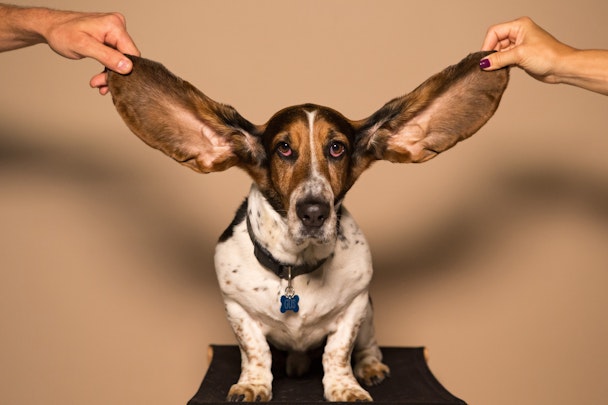Why brands need to start paying attention to ‘earconography’
Need evidence that sonic branding is a boom business for marketers? It’s gathering its own buzzwords – like ‘earconography,’ a portmanteau of ‘ear’ and ‘iconography.’ For The Drum’s Audio Deep Dive, Roscoe Williamson, global creative strategy director at MassiveMusic, tells us that, buzzword or not, now’s the time to take earconography seriously.

Earconography, sound UX, product sound – call it what you like, it’s a secret weapon for brand reach / Kyle Smith via Unsplash
‘Earconography’ sounds like a buzzword marketers and sonic brand experts drop into a pitch. To be honest, that’s exactly what it is. But this beguiling word also aptly describes the art and science of one of the most innocuous yet powerful recent developments in brand sound.
Consciously aware or not, we live in a constantly-evolving soundscape of branded earconography. These short, simple sounds are designed to support the user experience of a digital or physical product.
We’re seeing more creative uses for these sounds that expand into marketing, communications and brand experiences. The most obvious examples come from the products we use every day.
Take Twitter’s recent decision to reintroduce sound, literally heard by millions overnight. One sound is a charming short, microtrill-esque sound, designed to let you know you’ve just refreshed your feed. Another is a snappy, sunny glissando chirp that tells you that your new content has loaded.
Why has Twitter done this? Why risk potentially committing the design crime of going against Dieter Rams’ ‘less, but better’ cardinal product law?
The unparalleled reach of sound waves
Whatever you call them – earcons, product sounds, user experience (UX) sounds – make no mistake that these are a new breed of highly-effective brand assets. Tech brands especially are making the most of these. The likes of WhatsApp, Microsoft Teams, Apple and Skype are subtly littered with their brand’s notifications on features such as pay and start-up, all seamlessly integrated. It’s a highly effective technique, quickly bringing us into the brand world.
Just think of the reach and exposure these sounds have: heard by millions, sometimes billions, every day.
To gain this sort of reach through more traditional advertising channels would be incredibly expensive, so brands are leveraging these mini brand assets in creative ways. For example, the innocent-sounding Apple charging bleep at the end of this campaign about the iPhone XR’s battery Life, or the perennially alarming Teams connecting sound at the start of this Microsoft spot.
Once you start listening, you’ll hear they are everywhere. If you’re a marketer thinking about areas in a brand’s ecosystem, you can build up association through this reach, and work with it creatively in other channels and content forms.
Introducing ‘neomorphic’ sound
Meanwhile, as products and services become more automated (even dehumanized), sound can hugely support efforts to foster emotional connection. Take Apple’s recent decision to layer abstract, tonal sounds under sounds that were previously only ‘skeuomorphic.’ Skeuomorphic sounds sound just like the object you are trying to interact with in real life. Examples can include rubbish in the trash, files in a folder – now the minds at Apple have decided to switch this up. In recent upgrades of OSX, if you drag a file into a folder you won’t only hear the folder closing sound, but also a lush, warm, abstract tone supporting it.
Sound designers refer to this combination as ‘neomorphic’ sound: real life, mixed with the abstract and virtual. This is quite possibly a sign of things to come as we venture ever closer to the metaverse. Sound is a shortcut to human emotion and, when combined with reach, there’s a real possibility to positively affect brand perception and experience.
The unavoidable necessity of voice UX
Regardless of your opinion of smart speakers and voice UX, they are not going anywhere. If anything, once Amazon and the like start to provide brands with more search data, the upside will only become more apparent. How your brand shows up in a landscape void of visual stimulus is hugely important. We will hear earconography really coming to the fore – suites of functional, branded sounds that let you orient yourself around this emerging ecosystem, notifying you of updates, actions, errors and completed tasks as you go.
The implications for accessibility are huge. It’s refreshing to see brands like Twitter testing audible charts and graphs, but in the future many service processes such as onboarding, search and payments could one day work solely in the realm of audio. The brands putting in the groundwork now will be best-placed.
Embracing earconography today
To have a cohesive, congruent and holistic brand sound you need to have some fundamental guiding principles derived from what makes you unique as a brand: values; personality; tone of voice; principles. They should be created with knowledge of the sound of your competitive sector in order to differentiate, and be designed with your audience in mind. Context is key: where and how your audience will be hearing and interacting with your brand sound needs to be considered.
For example, the sound of the refresh button heard hundreds of times a day might want to be slightly more discreet than the celebratory music triggered during a trophy lift in a cup final. Think about music and sound from first principles and develop clear guidance on how to develop any sonic assets you may need – be that your hero sonic logo, branded music for content or indeed your imminently-approaching, disarmingly effective, earconography suite.
For more insight into the world of sonic branding, check out our Audio Deep Dive hub.
Content by The Drum Network member:

MassiveMusic
Find out more